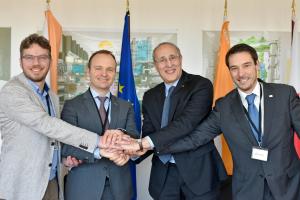Collaboration in diagnostics
Impurities in the line of sight
25 Feb 2019
-
Kirsten Haupt
Dutch research institutes TNO and DIFFER will be joining with Active Space Technologies (Europe) and Chromodynamics (Netherlands) to develop a diagnostic tool capable of measuring the impurity content of the plasma—important information for regulating neutral beam heating power on ITER.
Wouter Vijvers, Director of Chromodynamics; Kees Buijsrogge, Director of TNO; ITER Director-General Bernard Bigot; and Ricardo Patricio, Director of Active Space Technologies on the day of the signature (missing on the photo is DIFFER Director Richard van de Sanden).
The visible spectroscopy reference system (VSRS) will "look" into the plasma along a single sightline at a precisely defined angle. By analyzing the light emitted by the plasma along that line, it provides important information on the average impurity content, or "transparency" of the plasma.
The visible spectroscopy reference system (VSRS) operates a single viewing chord at a precisely defined angle to measure the visible light emitted by the ITER plasma. By collecting information on impurity content—and thus the relative transparency or opaqueness of the plasma—the diagnostic can provide an early warning for neutral beam shine through that could damage the ITER walls.
For ITER's main source of external heating, neutral beam injection, plasma impurity content is an important parameter. If the level if impurities is too high, the beam of neutral particles will be slowed—even stopped—in its trajectory and not enough energy will reach the centre of the plasma. If on the other hand impurity content is too low, the neutral beam could potentially "shine through" and hit the vacuum vessel wall, heating and possibly damaging inner wall components.
By monitoring the absorption rate of the beam's energy by the plasma, the visible spectroscopy reference system provides an early warning to trigger a reduction in neutral beam power before wall heating takes place.
A Cooperation Agreement was signed on 19 February for the design of the visible spectroscopy tool with the Netherlands Organisation for Applied Scientific Research (TNO), the Dutch Institute for Fundamental Energy Research (DIFFER), the European company Active Space Technologies and the Dutch startup Chromodynamics.
An early version will be made available for First Plasma in 2025 to survey the visible light emitted by the plasma and to help identify the types of impurities present. An updated version—optimized to monitor the absorption of heating neutral beam power—will be available by 2028 for later stages of pre-fusion power operation.



